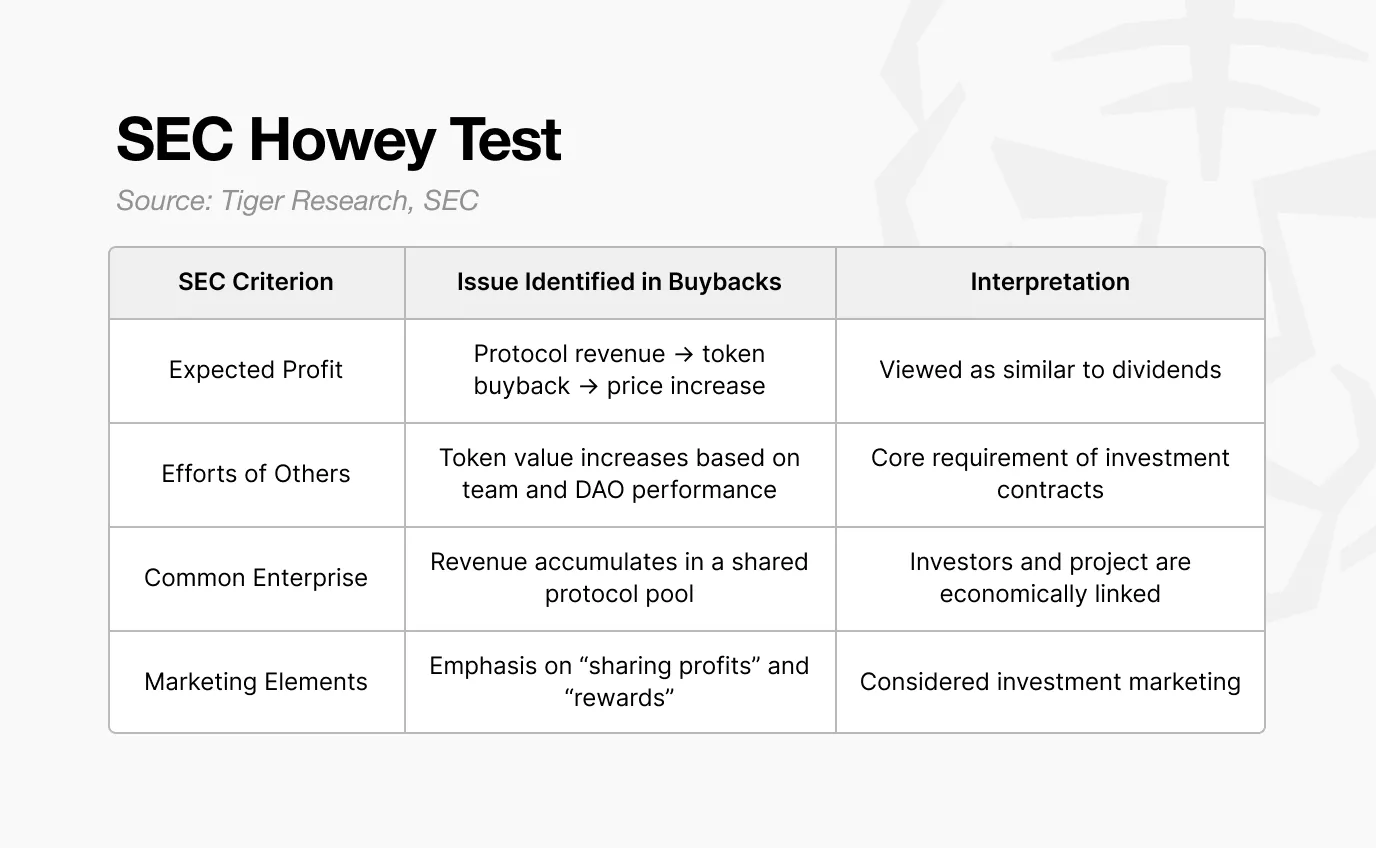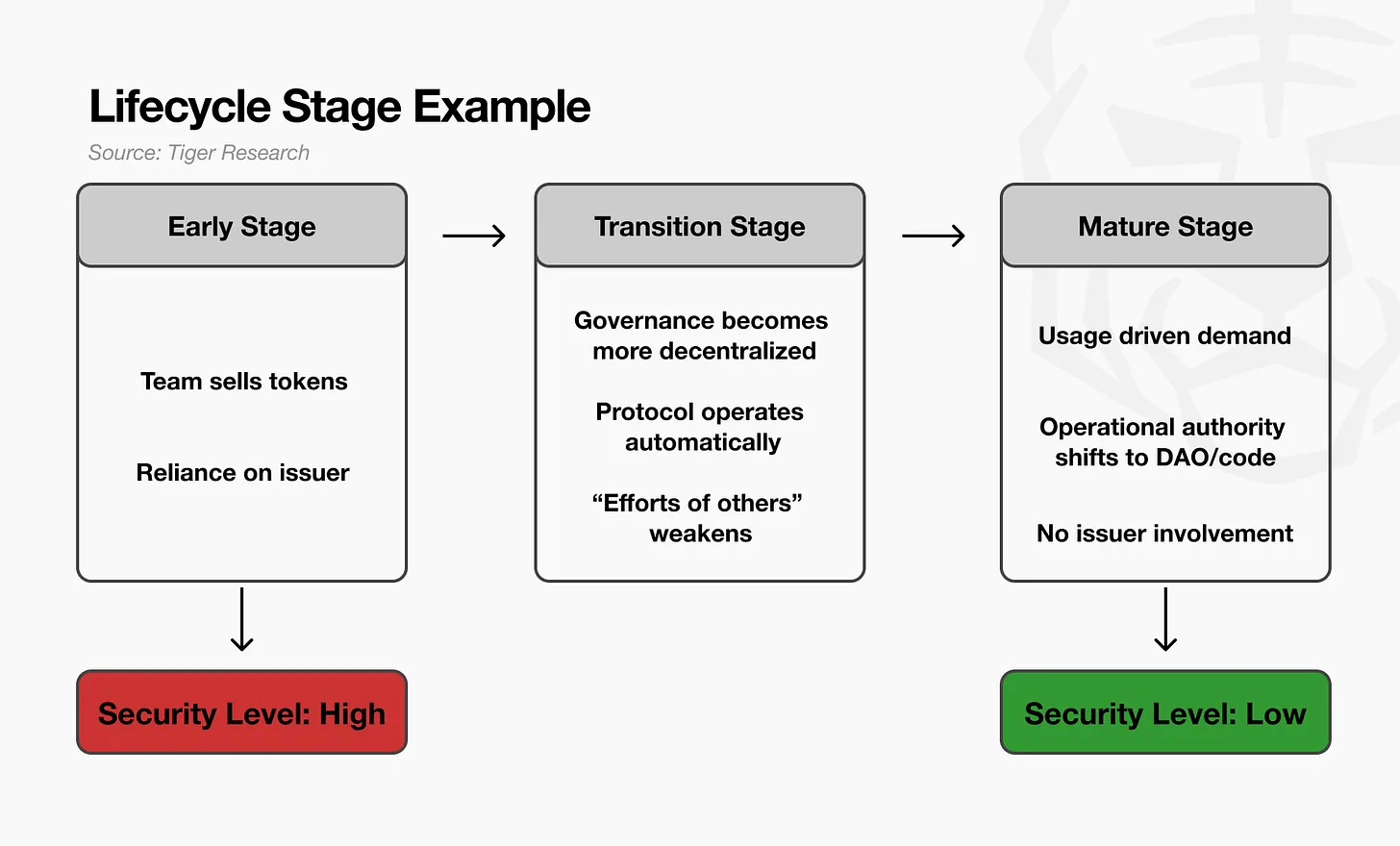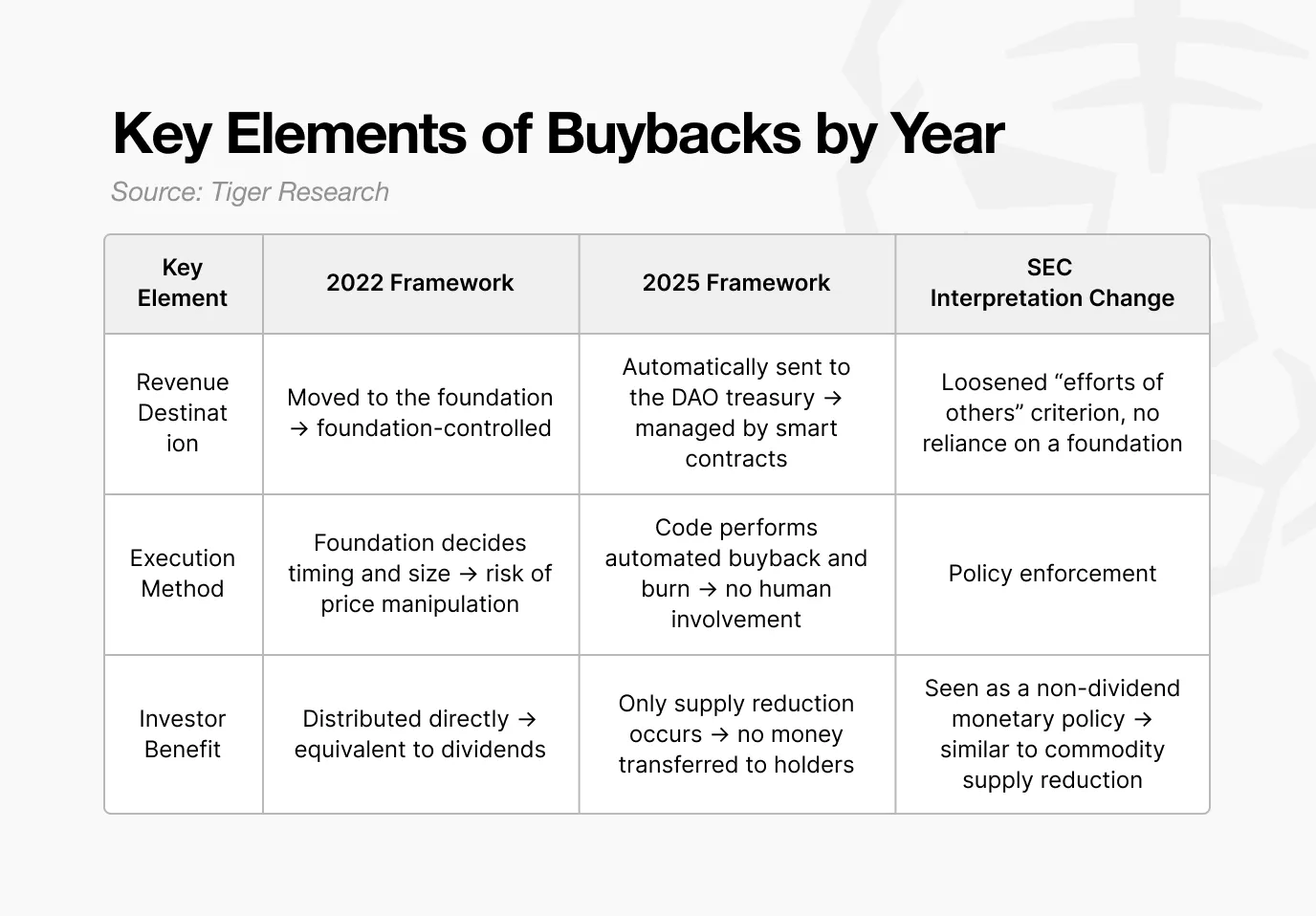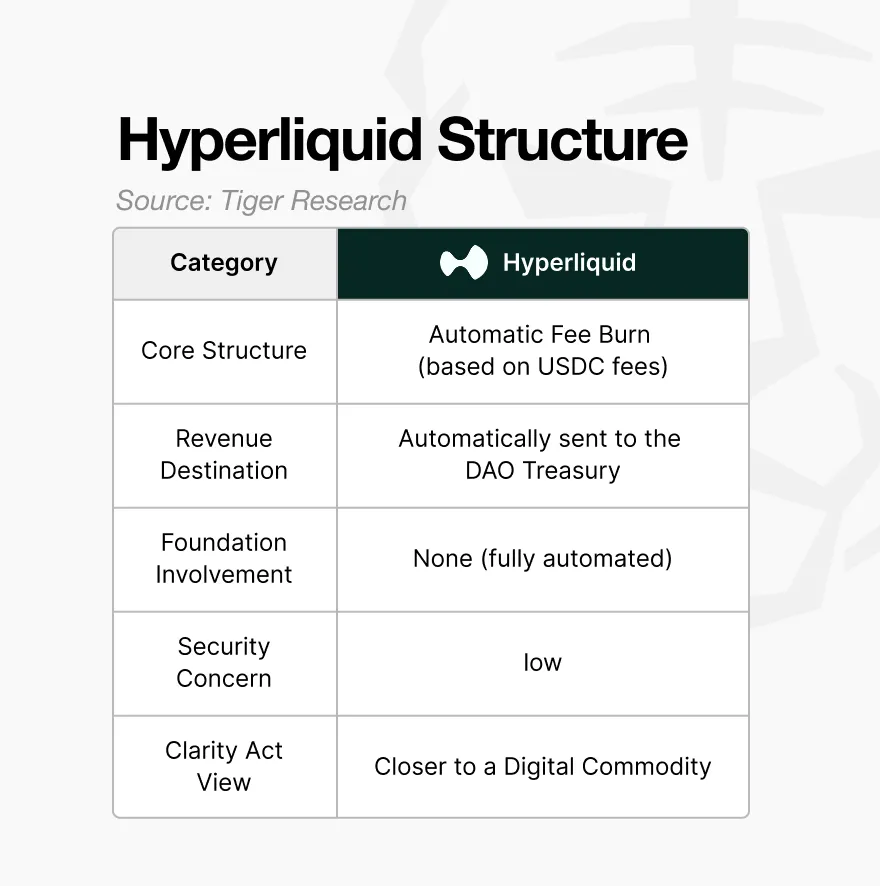Author: Ekko an and Ryan Yoon
The buyback, which stagnated in 2022 due to pressure from the U.S. Securities and Exchange Commission, has once again become a focal point. This report, written by Tiger Research, analyzes how this mechanism, once deemed unfeasible, has re-entered the market.
Key Points Summary
Hyperliquid's 99% buyback and the restart of buyback discussions by Uniswap have brought buybacks back into focus.
Buybacks, once considered impractical, are now possible due to the SEC's "crypto projects" and the introduction of the Clarity Act.
However, not all buyback structures are feasible, confirming that the core requirements of decentralization remain crucial.
1. Buybacks Make a Comeback After Three Years
Buybacks, which disappeared from the crypto market after 2022, re-emerged in 2025.
In 2022, the SEC viewed buybacks as activities subject to securities regulation. When a protocol uses its revenue to buy back its own tokens, the SEC considers this as providing economic benefits to token holders, essentially equivalent to dividends. Since dividend distribution is a core feature of securities, any token engaging in buybacks could potentially be classified as a security.
As a result, major projects like Uniswap either postponed their buyback plans or completely halted discussions. There was no reason to take on direct regulatory risks.
However, by 2025, the situation changed.
Uniswap has reopened its buyback discussions, and several protocols, including Hyperliquid and Pump.fun, have executed buyback plans. What was once deemed unfeasible has now become a trend. So, what has changed?
This report explores why buybacks were halted, how regulations and structural models have evolved, and how each protocol's approach to buybacks differs today.
2. Why Buybacks Disappeared: SEC's Securities Interpretation
The disappearance of buybacks is directly related to the SEC's view on securities. From 2021 to 2024, regulatory uncertainty in the entire crypto space was exceptionally high.
The Howey Test is the framework the SEC uses to determine whether an activity constitutes a security. It includes four elements, and assets that meet all the elements qualify as investment contracts.
Based on this test, the SEC repeatedly claimed that many crypto assets fall under the category of investment contracts. Buybacks were interpreted under the same logic. As regulatory pressure increased across the market, most protocols had no choice but to abandon their buyback plans.

The SEC did not view buybacks as a simple token economic mechanism. In most models, protocols use their revenue to buy back tokens and then distribute value to token holders or ecosystem contributors. In the SEC's view, this is akin to dividends or shareholder distributions after a company buyback.
As the four elements of the Howey Test align with this structure, the interpretation of "buyback = investment contract" became increasingly entrenched. This pressure was most severe for large protocols in the U.S.
Uniswap and Compound, operated by U.S. teams, faced direct regulatory scrutiny. Therefore, they had to be highly cautious when designing token economics and any form of revenue distribution. For example, Uniswap's fee switch has remained inactive since 2021.
Due to regulatory risks, major protocols avoided any mechanisms that would directly distribute revenue to token holders or could have a substantial impact on token prices. Terms like "price appreciation" or "profit sharing" were also removed from public communications and marketing.
3. Shift in SEC's Perspective: Crypto Projects
Strictly speaking, the SEC did not "approve" buybacks in 2025. What changed was its interpretation of what constitutes a security.
Gensler: Based on outcomes and behavior (How are tokens sold? Does the foundation directly distribute value?)
Atkins: Based on structure and control (Is the system decentralized? Who actually controls it?)
Under Gensler's leadership in 2022, the SEC emphasized outcomes and behavior. If revenue is shared, the token tends to be viewed as a security. If the foundation intervenes in a way that affects prices, it is also considered a security.
By 2025, under Atkins' leadership, the framework shifted to structure and control. The focus moved to who governs the system and whether operations rely on human decision-making or automated code. In short, the SEC began to assess the actual degree of decentralization.

Source: U.S. District Court for the Southern District of New York
The Ripple (XRP) lawsuit became a key precedent.
In 2023, the court ruled that XRP sold to institutional investors qualified as a security, while XRP traded by retail investors on exchanges did not. The same token could belong to different classifications based on its method of sale. This reinforced an interpretation that the security status does not depend on the token itself but rather on the method of sale and operational structure, directly impacting the assessment of buyback models.
These shifts were later integrated under an initiative called "crypto projects." After "crypto projects," the SEC's core questions changed:
Who actually controls the network? Are decisions made by the foundation or governed by a DAO? Is revenue distribution and token burning manually timed or automatically executed by code?
In other words, the SEC began to examine substantive decentralization rather than superficial structure. Two shifts in perspective became particularly critical.
- Lifecycle
- Functional Decentralization
3.1. Lifecycle
The first shift introduced the perspective of the token lifecycle.
The SEC no longer views tokens as permanently securities or permanently non-securities. Instead, it recognizes that the legal characteristics of tokens may change over time.

For example, in the early stages of a project, the team sells tokens to raise funds, and investors purchase tokens with the expectation that the team's strong execution will increase the token's value. At this point, the structure heavily relies on the team's efforts, making this sale functionally similar to a traditional investment contract.
As the network begins to see actual use, governance becomes more decentralized, and the protocol operates reliably without direct team intervention, the interpretation changes. Price formation and system operation no longer depend on the team's capabilities or ongoing work. A key element in the SEC's assessment—"reliance on the efforts of others"—is weakened. The SEC describes this period as a transitional phase.
Ultimately, when the network reaches a mature stage, the characteristics of the token are significantly different from its early stage. Demand is driven more by actual use rather than speculation, and the token functions more like a network commodity. At this point, applying traditional securities logic becomes difficult.
In short, the SEC's lifecycle perspective acknowledges that a token may resemble an investment contract in its early stages, but as the network becomes decentralized and self-sustaining, classifying it as a security becomes more challenging.
3.2. Functional Decentralization
The second shift is functional decentralization. This perspective focuses not on how many nodes exist but on who actually holds the control.
For example, a protocol may operate with ten thousand nodes globally, with its DAO tokens distributed among thousands of holders. On the surface, it appears completely decentralized.
However, if the upgrade permissions of the smart contract are held by a multi-signature wallet controlled by a three-person foundation, if the treasury is controlled by the foundation wallet, and if fee parameters can be directly changed by the foundation, then the SEC does not consider this decentralized. In reality, the foundation controls the entire system.
In contrast, even if a network operates with only one hundred nodes, if all significant decisions require DAO voting, if outcomes are automatically executed by code, and if the foundation cannot intervene at will, then the SEC may view it as more decentralized.
4. Clarity Act

In 2025, another factor that enabled the re-emergence of buyback discussions was the Clarity Act, a legislative initiative proposed by the U.S. Congress. This act aims to redefine how tokens should be classified under the law.
While the SEC's "crypto projects" focus on determining which tokens qualify as securities, the Clarity Act raises a more fundamental question: What are tokens as a legal asset?
The core principle is simple: a token does not permanently become a security merely because it is sold under an investment contract. This concept is similar to the SEC's lifecycle approach but is applied differently.
According to the SEC's previous interpretation, if a token is sold as part of an ICO investment contract, that token itself may be indefinitely viewed as a security.
The Clarity Act separates these elements. If a token is sold under an investment contract at issuance, it is considered an "investment contract asset" at that moment. But once it enters the secondary market and is traded by retail users, it is reclassified as a "digital commodity."
In simple terms, a token may be a security at issuance, but once it is sufficiently distributed and actively traded, it becomes an ordinary digital asset.
This classification is important because it changes the regulatory bodies involved. Initial sales fall under the SEC's jurisdiction, while secondary market activities fall under the CFTC's jurisdiction. As regulatory oversight shifts, the constraints related to securities regulation that protocols face when designing their economic structures are reduced.
This shift directly impacts how buybacks are interpreted. If a token is classified as a digital commodity in the secondary market, then buybacks are no longer viewed as "dividends similar to securities." Instead, they can be interpreted as supply management, akin to monetary policy in a commodity-based system. It becomes a mechanism for operating the token economy rather than distributing profits to investors.
Ultimately, the Clarity Act formalizes the idea that the legal characteristics of tokens may change depending on the context, reducing the structural regulatory burdens associated with buyback design.
5. Shift to Buybacks and Burns
In 2025, the combination of buybacks and automatic burn mechanisms re-emerged. In this model, revenue is not directly distributed to token holders, the foundation has no control over price or supply, and the burn process is executed algorithmically. Therefore, this structure further distances itself from the elements previously marked by regulators.

The "Unification Proposal" announced by Uniswap in November 2025 clearly illustrates this shift.
In this model, a portion of the trading fees is automatically allocated to the DAO treasury, but no revenue is directly distributed to UNI holders. Instead, a smart contract purchases UNI on the open market and burns it, thereby reducing supply and indirectly supporting value. All decisions governing this process are made through DAO voting, with no intervention from the Uniswap Foundation.
The key change lies in the interpretation of this action.
Early buybacks were viewed as a form of "profit distribution" to investors. The 2025 model redefines this mechanism as supply adjustment, functioning as part of network policy rather than intentionally influencing price.
This structure does not conflict with the SEC's 2022 viewpoint and aligns with the "digital commodity" classification defined in the Clarity Act. Once a token is viewed as a commodity rather than a security, supply adjustments resemble a monetary policy tool rather than a dividend-like payment.
The Uniswap Foundation stated in its proposal that "the environment has changed" and that "regulatory clarity in the U.S. is evolving." The key insight here is that regulators have not explicitly authorized buybacks. Instead, clearer regulatory boundaries allow protocols to design models that meet compliance expectations.
In the past, any form of buyback was seen as a regulatory risk. By 2025, the question shifted from "Is buyback allowed?" to "Can its design avoid triggering securities concerns?"
This shift opened up space for protocols to implement buybacks within a compliance framework.
6. Protocols Implementing Buybacks
A representative protocol executing buybacks and burn mechanisms in 2025 is Hyperliquid. Its structure illustrates several decisive features:
Automated Mechanism: Buybacks and burns operate based on protocol rules rather than discretionary decisions by the foundation.
Non-Foundation Revenue Streams: Revenue does not flow into wallets controlled by the foundation, or even if it does, the foundation cannot use it to influence prices.
No Direct Fee Sharing: Revenue is not paid to token holders. It is only used for supply adjustments or network operational costs.
The key point is that this model no longer commits to providing direct economic benefits to token holders. It functions as the network's supply policy. The mechanism has been redesigned to fit within the boundaries that regulators are willing to accept.

However, this does not mean that all buybacks are safe.
Although buybacks have regained momentum, not every implementation carries the same regulatory risk. The regulatory shift in 2025 opened the door for structurally compliant buybacks, rather than discretionary, one-off, or foundation-driven plans.
The SEC's logic remains consistent:
If the foundation decides when to purchase in the market, it reinforces the interpretation of "intentionally supporting prices."
Even with DAO voting, if upgrade or execution authority ultimately rests with the foundation, it does not meet decentralization requirements.
If value accumulates to specific holders rather than being burned, it resembles dividends.
If revenue flows from the foundation to market purchases, leading to price appreciation, it reinforces investor expectations and aligns with the elements of the Howey Test.
In short, discretionary, incidental, or foundation-controlled buybacks still cannot escape securities scrutiny.
It is also important to note that buybacks do not guarantee price appreciation. Burning reduces supply, but it is merely a long-term token economic mechanism. Burning cannot strengthen weak projects; rather, strong projects can enhance their fundamentals through well-designed burn systems.
免责声明:本文章仅代表作者个人观点,不代表本平台的立场和观点。本文章仅供信息分享,不构成对任何人的任何投资建议。用户与作者之间的任何争议,与本平台无关。如网页中刊载的文章或图片涉及侵权,请提供相关的权利证明和身份证明发送邮件到support@aicoin.com,本平台相关工作人员将会进行核查。



